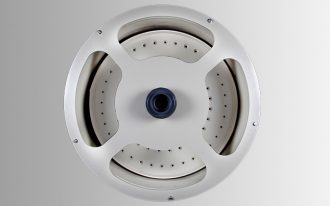Aquarium Trickle Filters Technology & Engineering

MAT Life Support Systems design and build highly effective trickling filters. A trickle filter is a type of sewage water treatment system. It is a biotower, a canister with patent designed chambers that consist of a fixed porous bed, that can either be ceramic or plastic media over which aquaculture primal wastewater flows downward and causes a layer of microbial slime (biofilm) to grow, covering the bed of media. Aerobic conditions are maintained by splashing, diffusion, and either by forced air flowing through the bed or by creating a vacuum system to suck off the generated carbon dioxide. The MAT trickle filter vacuum system maximizes by 40% the oxygen concentration on the close circuit water systems.
The terms trickle filter, biofilter, biological filter, trickling bio-filter & biological trickling filter are often used to refer to a trickling filter. These systems may also be referred as roughing filters, intermittent filters, packed media bed filters, alternative septic systems, percolating filters, attached growth processes & fixed film processes.
Biochemical oxygen demand & Trickle Filters
One of the most commonly measured constituents of aquaculture wastewater is the biochemical oxygen demand, or BOD. Wastewater is composed of a variety of pathogen and organic substances. Organic substances refer to molecules that are based on protein & carbon and include fecal matter as well as fats, greases and fish food particles.
These large organic molecules are easily decomposed by bacteria in a MAT Trickle LSS System. However, oxygen is required for this process of breaking large molecules into smaller molecules and eventually into carbon dioxide and water. The amount of oxygen required for this process is known as the biochemical oxygen demand or BOD.
Because BOD serves as a food source for microbes, BOD supports the growth of the microbial biomat which forms as a biofilm on the surface of the bead media inside the trickle filters. This is both good and bad. On the one hand, a healthy biomat is desired because it is capable of removing many of the bacteria and viruses from the waste water. The bacteria in a healthy biomat also digest most of the remaining BOD. Too much BOD, however, can cause excessive growth of bacteria in the biomat. If the BOD is so high that all available oxygen is consumed the biofilm will turn to anaerobic. This causes the desirable bacteria and protozoans in the biobead to die, resulting in diminished treatment of the waste water. Low oxygen in the biobead also encourages the growth of anaerobic bacteria (bacteria which do not require oxygen for growth).
Εffectiveness in Water Treatment
Many anaerobic bacteria produce a mucilaginous coating which can quickly clog the bead filter of the trickle filter. Thus, excess BOD in sewage can cause a trickle filter to function poorly and even to fail prematurely. This is why the MAT vacuum TRICKLE SYSTEM is essential for high bioload aquaculture facilities.
BOD is fairly easy to remove from sewage by providing a supply of oxygen during the treatment process; the oxygen supports bacterial growth which breaks down the organic BOD. Most enhanced LSS treatment units incorporate some type of unit which actively oxygenates the WASTEWATER to reduce BOD. It is also important to note that BOD serves as the food source for the denitrifying bacteria which are needed in LSS systems where bacterially-mediated nitrogen removal takes place. In these situations BOD is desired, as the nitrification/de-nitrification process cannot operate efficiently without sufficient BOD to support the growth of the bacteria which accomplish the process.
View all series of Aquarium Trickle Filters with Technical Information Data Sheet.
View all Trickle Filters